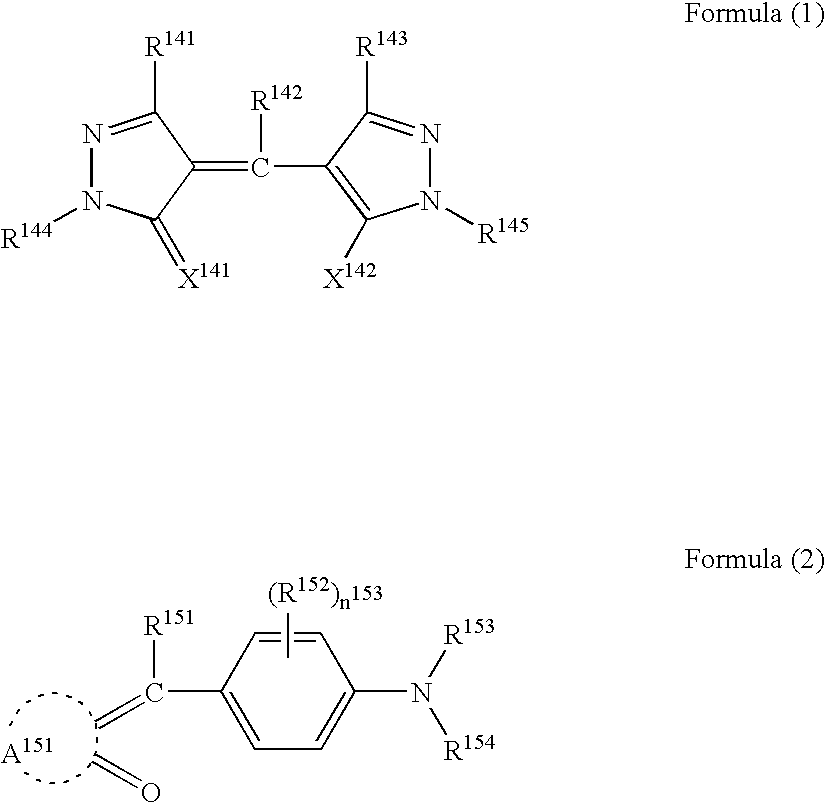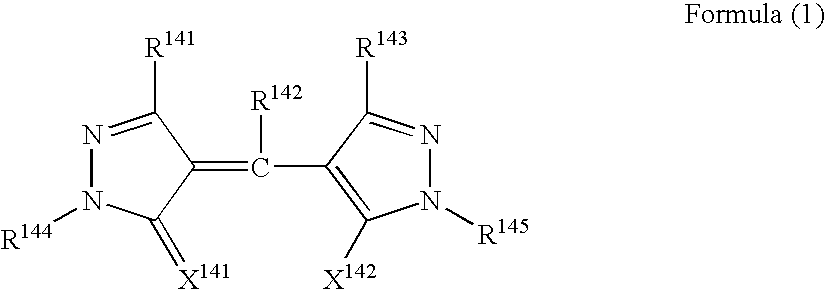Image-forming method using heat-sensitive transfer system
a transfer system and heat-sensitive technology, applied in the direction of diffusion transfer process, thermography, instruments, etc., can solve the problem of not disclosing any such dye-transfer
- Summary
- Abstract
- Description
- Claims
- Application Information
AI Technical Summary
Benefits of technology
Problems solved by technology
Method used
Image
Examples
production example 1
Preparation of Heat-Sensitive Transfer Sheets 1 to 8
[0205] A polyester film having 6.0 μm in thickness (trade name: Lumirror, manufactured by Toray Industries, Inc.), the back side of which had been subjected to a heat-resisting and sliding (smoothing) treatment with a thermosetting acryl resin (thickness: 1 μm), was used as the support. To the surface of the above-described polyester film, a thermal transfer layer-coating solution was applied by a wire bar coating so that the coating amount after dry could become 1 g / m2, thereby to prepare a heat-sensitive transfer sheet 8 having a thermal transfer layer on the support.
[0206]
Yellow dye 1 for comparison5.5 parts by mass(Trade name: Macrolex Yellow 6G, manufacturedby Byer)Polyvinylbutyral resin4.5 parts by mass(Trade name: S-LEC BX-1, manufactured bySekisui Chemical Co., Ltd.)Methyl ethyl ketone / toluene (1 / 1, at mass ratio) 90 parts by mass
[0207] Next, heat-sensitive transfer sheets 1 to 7 were prepared in the same manner as the he...
production example 2
Preparation of Heat-Sensitive Transfer Image-Receiving Sheets 11 to 13
(Preparation of support A)
[0208] A pulp slurry was prepared from 50 parts by mass of hardwood kraft pulp (LBKP) of acacia origin and 50 parts by mass of hardwood kraft pulp (LBKP) of aspen origin, by beating these pulps by means of a disk refiner until Canadian standard freeness reached to 300 ml.
[0209] To the pulp slurry thus prepared were added, on a pulp basis, 1.3 mass % of modified cationic starch (CAT0304L, trade name, manufactured by Nippon NSC), 0.15 mass % of anionic polyacrylamide (DA4104, trade name, manufactured by Seiko PMC Corporation), 0.29 mass % of an alkylketene dimer (SIZENPINE K, trade name, manufactured by Arakawa Chemical Industries, Ltd.), 0.29 mass % of epoxidated behenic acid amide, and 0.32 mass % of polyamide polyamine epichlorohydrin (ARAFIX 100, trade name, manufactured by Arakawa Chemical Industries, Ltd.), and thereafter 0.12 mass % of a defoaming agent was further added.
[0210] ...
example 1
Image Recording and Evaluation
[0220] Each of the heat-sensitive transfer sheets 1 to 8 prepared in Production Example 1 and each of the heat-sensitive transfer image-receiving sheets 11 to 13 prepared in Production Example 2 were superposed so that the receptor layer of the heat-sensitive transfer image-receiving sheet could be contacted with the thermal transfer layer of the heat-sensitive transfer sheet. Printing was performed using a thermal head on the back side of the heat-sensitive transfer sheet under the conditions of 0.25 W / dot of output of the thermal head, 0.15 to 15 msec. of pulse width, and 6 dots per mm2 of dot density. Thus, dyes were dyed to the receptor layer of the heat-sensitive transfer image-receiving sheet so that each monochrome and gray could be made.
[0221] Spectral absorbance of the heat-sensitive transfer sheets used for the printing described above was measured before and after the transferring, to evaluate the transfer rate. The transfer rate was evalua...
PUM
| Property | Measurement | Unit |
|---|---|---|
| thickness | aaaaa | aaaaa |
| thickness | aaaaa | aaaaa |
| thickness | aaaaa | aaaaa |
Abstract
Description
Claims
Application Information
 Login to View More
Login to View More - R&D
- Intellectual Property
- Life Sciences
- Materials
- Tech Scout
- Unparalleled Data Quality
- Higher Quality Content
- 60% Fewer Hallucinations
Browse by: Latest US Patents, China's latest patents, Technical Efficacy Thesaurus, Application Domain, Technology Topic, Popular Technical Reports.
© 2025 PatSnap. All rights reserved.Legal|Privacy policy|Modern Slavery Act Transparency Statement|Sitemap|About US| Contact US: help@patsnap.com



